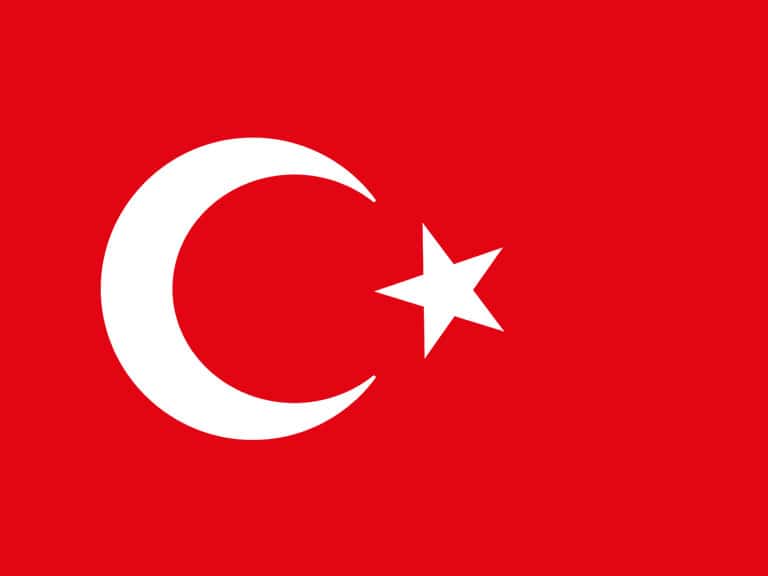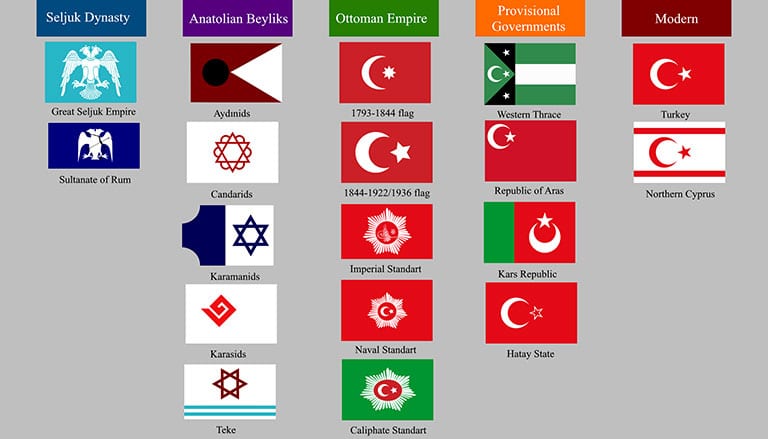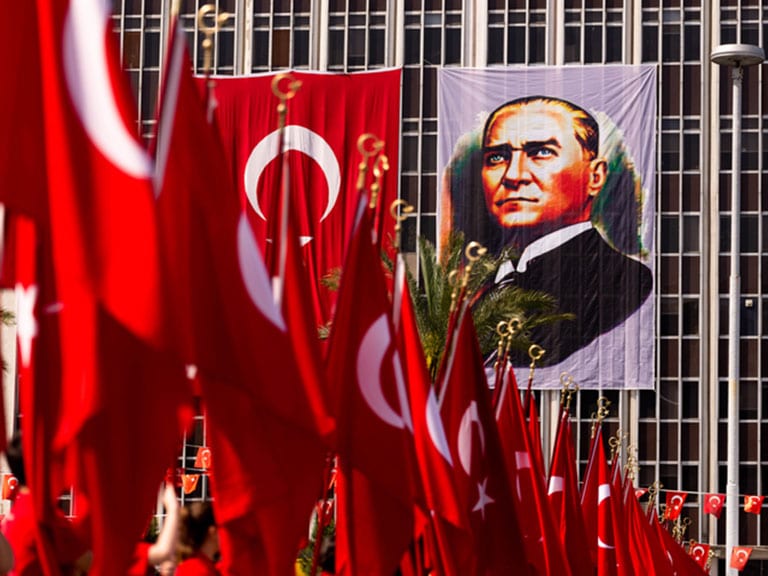If you’re heading to Turkey, it may be best to brush up on your history of the magnificent destination. One feature is incredibly iconic and has a rich and exciting history behind it- the Turkish flag. The flag has tons of little fundamentals that will spice up your visit to the country. Where did it come from anyway? What is the story behind the symbols and colors?
These features of the flag may seem subtle, but they tell a tale of Turkey’s history that you won’t find in the numerous monumental pieces of architecture scattered across the country. Therefore, let us bring you the Turkish flag, a symbol with a rich history full of conflict and triumph.
1. Turkish Flag Today
As part of the Ottoman Empire, the flag underwent many changes until the 2nd half of the 18th century. For one, it wasn’t always red; in the 14th century, it was white. In the 15th century, it was red, but it didn’t stay this way. At one point, it was three white crescents on a green background. The three crescents were thought to symbolize the influence of Islam on the three major continents.
Today, the Turkish Flag consists of a centralized crescent and a white star over a red background. It has a width-to-length ratio of approx. 2 to 3, and the red color has been a significant part of Turkish Flags for over 700 years.
It isn’t so much different from the Ottoman version that it came from, although the star and crescent shapes are slightly thinner. They’re also working on a system of direct dimensions that became part of the law back in 1936 and is still in effect to date.

2. Where Do the Star and Crescent Come From?
The star and crescent were initially a symbol of the Ottoman Empire, whose use started during the second half of the 18th century. Nonetheless, the star and crescent iconography date further back in history, long before the Ottoman Turks conquered Turkey.
The symbols developed during the Hellenistic period, between the 4th and 1st century BC, in the kingdoms of Pontus and Bosporan and the city of Byzantium. They were also used in the Near East to represent the moon and the morning star.
3. Are They Symbols of Islam?
Most people associate the star and crescent symbols on the flag with Islam. Nonetheless, their origins go back a little further than that to the people of Siberia and Central Asia. These communities worshiped gods associated with the moon, sun, and sky. Therefore, they made use of the star and crescent symbols during their worship.

4. Other Countries that Use a Crescent and Star
Turkey isn’t the only country that is using the crescent and star on its flag. By the 20th century, Algeria, Tunisia, and Azerbaijan started using the crescent and star symbols on their flags, which they still use today. This use of the crescent and the star is because they were all the Ottoman Empire’s successor states.
Apart from these successor states, other countries that use these symbols are Mauritania and Pakistan.
5. Turkish Flag Legends
The Battle of Kosovo
There are many different legends said to have influenced the overall look of the flag. One of the most famous of these legends stems from the Battle of Kosovo, which occurred in 1448. It was a battle between Lazlar, a Siberian prince, and the Ottoman sultan Murad I, which ended in a victory for the Ottoman Empire.
It is said that when one of the commanders was looking about the war-torn field, they saw a reflection of the star and crescent in a pool of blood. This is where the flag gets its striking red color.
Ottoman Sultan’s Dream
A second legend references a dream that the first Ottoman Sultan, Osman I, had. In the tale, the sultan wished to marry the daughter of the judge of the Sharia court. One night, he had a dream where the moon and star symbol shot out of the judge’s chest and into the sultan’s chest. Once the characters reached the sultan’s chest, a large tree with billowing branches came to life and engulfed everything in a shadow.
When the Ottoman Empire overtook the city of Constantinople in 1453, the reigning empire decided to use the symbols in the sultan’s dream because they were thought to be a good omen.
Goddess Diana
Diana was the goddess of the hunt, wild animals, domestic animals, and the fertility deity believed to help women through conception and childbirth. The symbols in the flag are thought to honor her in some way. Theory dictates the city of Byzantium (which would eventually become Istanbul) picked out these symbols in honor of Diana.
6. Fundamentals of the Turkish Flag
There are certain fundamentals of the Turkish flag that are laid down by the law. For one, if a flag becomes old or torn, it must be taken down and replaced with a fresh new one. Also, the flag cannot be sat or stepped on for any reason.
The flag must be hoisted at schools and other official buildings on holidays and during the weekends. On Monday mornings, students gather and salute the national flag.

7. Proud of the Turkish Flag
Every single building has at least one flag on the premises. The only buildings where it’s always raised are the Parliament building and the Mausoleum of Ataturk. However, you can see it on almost every street in the country, as we Turks are proud of it.
The Turkish military uniforms all have a flag patch on them. These patches are worn on their right shoulder or the front of the uniform.
Learn More Facts About the Turkish Flag
If you’re heading to Turkey, learning at least a little bit about its history will make you familiar with the country even before you set foot in it. The Turkish flag’s history is a great place to begin since it familiarizes you with one of the most iconic and loved symbols of the republic.
Although there are many legends and theories of where the symbols and color came from, one thing never changes—the power and endless beauty of the nation which it represents.
Do you want to see the flag up close and personal? Contact us to schedule or ask about a tour.
